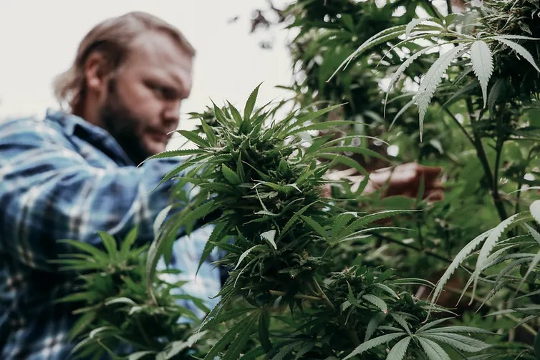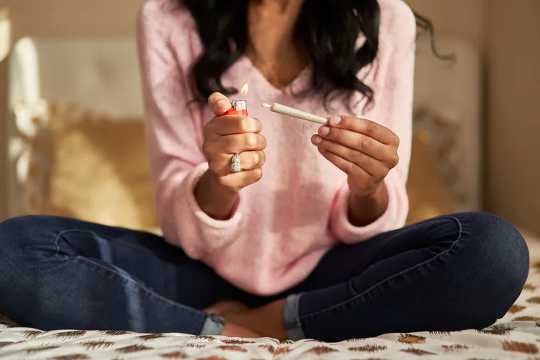 You reap what you sow. Lindsay Fox, CC BY-SA
You reap what you sow. Lindsay Fox, CC BY-SA
Back in the days when “skunk” was mainly associated with Pepé Le Pew and hydroponics was a way of improving cucumbers, most of the UK’s cannabis supply was imported from places such as Morocco and Lebanon. This changed in the past two or three decades in the UK and many other countries as organised criminal gangs set up growing operations closer to home.
Cannabis was still cultivated and distributed out of the more exotic locations on a large scale, particularly when it came to resin, but a fair amount of production had now moved closer to the demand in a process economists call import substitution.
It is hard to measure this accurately, but the Independent Drug Monitoring Unit estimated that by 2012, 80% of the cannabis used in the UK was grown here – up from 30% in the late 1990s. It is probably well over 90% now.
But in recent years, cannabis has undergone another major shift. A sizeable share of demand is now met by small-scale growers, mainly supplying themselves and friends and acquaintances. This has become possible for various reasons, including improvements to growing technology, new strains more suited to indoor growing, and the wealth of information and expertise on the internet. As such, many cannabis users no longer depend on traditional drug dealers.
Get The Latest By Email
This trend has been gaining momentum during the pandemic. So is this permanent or will the old supply chains reassert themselves when countries return to some kind of normality?
Keeping up with cannabis
Myself and a group of like-minded cannabis researchers across Europe, North America and Australasia formed the Global Cannabis Cultivation Research Consortium in 2009 to monitor the growth of domestic cultivation and how cannabis markets were evolving.
In 2012, we surveyed growers in Australia, Austria, Belgium, Canada, Denmark, Finland, Germany, the Netherlands, Switzerland, the UK and the US to find out more about small-scale growing, and how and why they these people got involved. Most turned out to be regular people - with normal jobs, normal family arrangements, and no more involvement in drug dealing or other crime than any other section of the public.
Cannabis policy has since been changing around the world. An ever-growing list of countries has legalised it, in some form, for medical use. A number have changed their laws so that cannabis possession (and, in some cases, cultivation for personal use) is no longer a criminal offence. Most significantly, Canada, Uruguay and various US states have legalised not only medical but recreational use too.
In 2020, we launched our second international survey to see how cultivation was being affected by this shifting backdrop. This time we looked at 18 countries, adding France, Georgia, Israel, Italy, New Zealand, Portugal and Uruguay to the original 11, while also running a survey for people in non-participating countries. A global pandemic and national lockdowns had not been part of our planning, but of course we added questions to find out the effects.
The new findings
Since COVID-19 has affected almost every area of life, you would expect it to affect drug use and drug markets. People have been spending more time at home. Social interactions have been limited, including opportunities to take drugs with friends or to obtain them from the usual sources. Meanwhile, national and international drug supply networks have been disrupted.
Sure enough, our preliminary findings suggest that COVID-19 has affected domestic cannabis cultivation around the world. With nearly 5,000 participants at the time of writing, 16% report only becoming involved in cannabis growing since the pandemic. There are 11% of respondents saying that having more time at home was why they were growing, while 8% cite increased cannabis prices during the pandemic as a motivating factor.
More than one-third of respondents reported that it was harder to meet up in person with people they grew with, or to obtain cannabis through personal social networks or their usual dealer. Yet fewer than one in ten reported that it was harder to get hold of cannabis seeds, growing equipment, or other supplies like fertilisers.
There is some interesting variation between countries in the findings. In Italy, more than one-quarter of respondents had started growing since the pandemic started – noticeably above the global average. Meanwhile, one-third of Portuguese respondents cited a shortage of cannabis during COVID-19 as a reason for growing their own.
Besides the pandemic, most home growers across the world pointed to other motivations that were in line with our 2012 findings: wanting a product that is healthier and cheaper, while avoiding contact with criminals.
Three-quarters of respondents report that they grow cannabis because they get pleasure from doing so. Nearly half report that they are growing for their own medical use. And while 15% report growing to supply others with cannabis for medical use and 15% supply others for recreational use, our growers are not acting as drug dealers: only 4% reported selling cannabis for profit.
 ‘The fruits of my labours.’ Joshua Resnick
‘The fruits of my labours.’ Joshua Resnick
But if lockdown has led a significant number of people to start growing their own cannabis, it is also important to note that the vast majority of our participants were growing it already. And while many respondents (18%) reported growing more under lockdown, one in ten said they were growing less or had stopped altogether. Meanwhile, organised crime continues to supply a large chunk of the UK cannabis market.
It must be stressed that these are only preliminary findings. We want to double the number of respondents to at least 10,000 in the coming months, and will publish the final results early in 2022. Then we intend to carry on our research to see if these trends continue as the pandemic recedes. We strongly suspect it will: once people get the habit of growing their own, there is little reason to go back to buying from dealers.
Anyone interested in taking part in our survey can find out more at worldwideweed.nl.![]()
About The Author
Gary Potter, Reader in Criminology, Lancaster University
This article is republished from The Conversation under a Creative Commons license. Read the original article.
books_herbs







